The Young Bengal was a group of Bengali free thinkers emerging from Hindu College, Calcutta. They were also known as Derozians, after their firebrand teacher at Hindu College, Henry Louis Vivian Derozio.

Sir Romesh Chandra Mitra or Romesh Chunder Mitter was an Indian judge and the first Indian officiating Chief Justice of the Calcutta High Court. Sir Romesh Mitra Girls school was founded in his honour in 1897. The school located in Bhowanipore is affiliated to the Central Board of Secondary Education.
Fort William College was an academy of oriental studies and a centre of learning, founded on 18 August 1800 by Lord Wellesley, then Governor-General of British India, located within the Fort William complex in Calcutta. Wellesley started the Fort William College to train the European administrators. He backdated the statute of foundation to 4 May 1800, to commemorate the first anniversary of his victory over Tipu Sultan at Seringapatam. Thousands of books were translated from Sanskrit, Arabic, Persian, Bengali, Hindi, and Urdu into English at this institution.
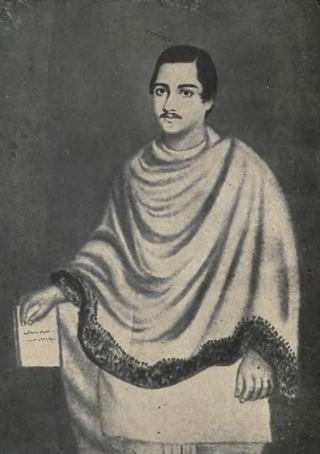
Kaliprasanna Singha, well known by his pen name Hootum Pyancha, was a Bengali author, playwright, and philanthropist. His most famous work was the translation of the ancient Hindu epic Mahabharata into Bengali. Singha's book Hootum Pyanchar Naksha, a compilation of satirical social sketches, is another work that is noted for reflecting Bengalee urban society of the time. He is also remembered as a philanthropist who helped several people and movements in distress.

The Bardhaman Raj, also known as Burdwan Raj, was a zamindari Raja estate that flourished from about 1657 to 1955 in the Indian state of West Bengal. Maharaja Sangam Rai Kapoor, a Khatri from Kotli, Punjab, who was the first member of the family to settle in Bardhaman, was the original founder of the house of Bardhaman, whereas his grandson Abu Rai, during whose time the zamindari started flourishing, is considered to be the patriarch of the Bardhaman Raj family.
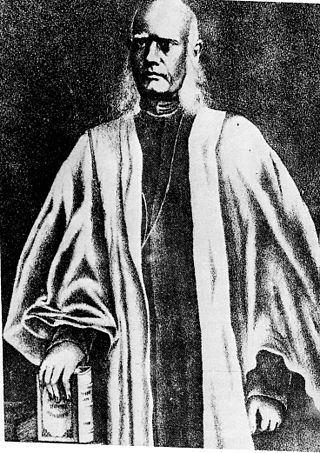
Krishna Mohan Banerjee was a 19th-century Indian thinker who attempted to rethink Hindu philosophy, religion and ethics in response to the stimulus of Christian ideas. He himself became a Christian, and was the first president of the Bengal Christian Association, which was administered and financed by Indians. He was a prominent member of Henry Louis Vivian Derozio's (1808–1831) Young Bengal group, educationist, linguist and Christian missionary.

Peary Chand Mitra was an Indian writer, journalist, cultural activist and entrepreneur. His pseudonym was Tek Chand Thakur. He was a member of Henry Derozio's Young Bengal group, who played a leading role in the Bengal renaissance with the introduction of simple Bengali prose. His Alaler Gharer Dulal pioneered the novel in the Bengali language, leading to a tradition taken up by Bankim Chandra Chatterjee and others. Mitra died on 23 November 1883 in Kolkata.
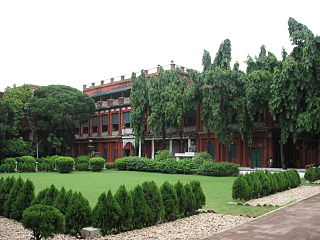
Jorasanko is a neighbourhood of North Kolkata, in Kolkata district, West Bengal, India. It is so called because of the two (jora) wooden or bamboo bridges (sanko) that spanned a small stream at this point.
Gobindram Mitter was one of the earliest Indian officials during the Company rule in India, who earned reputation for his wealth and extravagance.
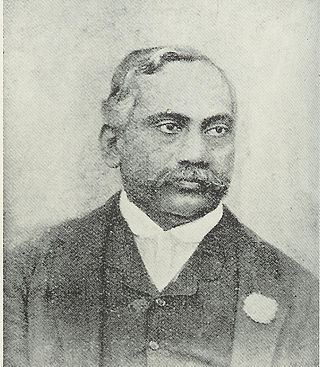
Manmohun Ghose was the first practicing barrister of Indian origin. He is notable for his contributions towards the fields of women's education, for arousing the patriotic feeling of his countrymen and for being one of the earliest persons in the country in organised national politics. At the same time his Anglicised habits often made him a target of ridicule in Calcutta.
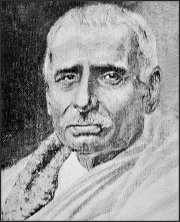
Hara Prasad Shastri, also known as Hara Prasad Bhattacharya, was an Indian academic, Sanskrit scholar, archivist, and historian of Bengali literature. He is most known for discovering the Charyapada, the earliest known examples of Bengali literature.

Raja Digambar Mitra (1817–1879) was one of the leading Derozians and first Bengali Sheriff of Kolkata.

History of Bankura district refers to the history of the present Bankura district in the Indian state of West Bengal.
Raja Sir Radhakanta Deb Bahadur KCSI was a scholar and a leader of the Calcutta conservative Hindu society, son of Gopimohan Deb of Shovabazar Raj who was the adopted son and heir of Maharaja Nabakrishna Deb of Shovabazar Raj.
The Hindoo Patriot was an English weekly published from Calcutta in the later half of the nineteenth century in Bengal.
Premananda Dutta was a Bengali revolutionary and activist of Indian freedom struggle attached with Chittagong Rebellion against the British Government in India.

Ramgopal Ghosh was a leader of the Young Bengal Group, a successful businessman, orator and social reformer. He is called the 'Demosthenes of India'. Ghosh was one of the personalities who helped John Elliot Drinkwater Bethune establish a girls' school in Calcutta.
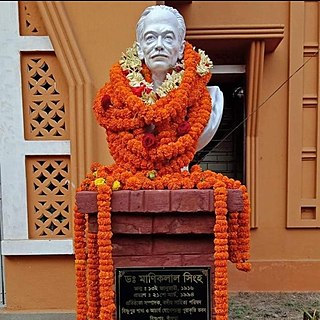
Maniklal Sinha, also Maniklal Singha; was an Indian archaeologist, writer, poet, folk-culture scholar (Lokasangskritibid), novelist and assistant teacher at Bishnupur High School. He was the main entrepreneur and founding director of Acharya Jogesh Chandra Pura Kirti Bhavan(museum) and Bangiya Sahitya Parishad – Bishnupur Branch in 1951 at Bishnupur. He was awarded an honorary D.Litt. degree by the University of Burdwan in 1989 for his contribution as an archaeologist, writer and novelist.












